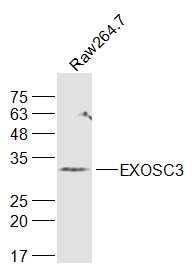产品货号 : mlR23099
英文名称 : EXOSC3
中文名称 : 核糖体RNA合成蛋白40抗体
别 名 : bA3J10.7; CGI 102; Exosome complex component RRP40; Exosome complex exonuclease RRP40; Exosome component 3; hRrp 40; hRrp40; hRrp40p; p10; PCH1B; Ribosomal RNA processing protein 40; Ribosomal RNA-processing protein 40, S. cerevisiae, homolog of; RP11-3J10.8; RRP 40; Rrp40; Rrp40p; EXOS3_HUMAN.
研究领域 : 细胞生物 合成与降解 表观遗传学
抗体来源 : Rabbit
克隆类型 : Polyclonal
交叉反应 : Human, Mouse, Rat, Chicken, Horse, Rabbit, Sheep,
产品应用 : WB=1:500-2000 ELISA=1:500-1000 IHC-P=1:400-800 IHC-F=1:400-800 ICC=1:100-500 IF=1:100-500 (石蜡切片需做抗原修复)
not yet tested in other applications.
optimal dilutions/concentrations should be determined by the end user.
分 子 量 : 29kDa
细胞定位 : 细胞核 细胞浆
性 状 : Lyophilized or Liquid
浓 度 : 1mg/ml
免 疫 原 : KLH conjugated synthetic peptide derived from human EXOSC3:101-200/275
亚 型 : IgG
纯化方法 : affinity purified by Protein A
储 存 液 : 0.01M TBS(pH7.4) with 1% BSA, 0.03% Proclin300 and 50% Glycerol.
保存条件 : Store at -20 °C for one year. Avoid repeated freeze/thaw cycles. The lyophilized antibody is stable at room temperature for at least one month and for greater than a year when kept at -20°C. When reconstituted in sterile pH 7.4 0.01M PBS or diluent of antibody the antibody is stable for at least two weeks at 2-4 °C.
PubMed : PubMed
产品介绍 : The exosome is a multisubunit complex of 3’ to 5’ exoribonucleases. It is involved in a variety of cellular processes and is responsible for degrading unstable mRNAs that contain AU-rich elements in their untranslated 3’ region. EXOSC3 (exosome component 3), also known as p10, CGI-102, RRP40 (Ribosomal RNA-processing protein 40), Rrp40p or hRrp40p, is a component of the exosome multienzyme ribonuclease complex. Localizing to the cytoplasm and nucleolus, EXOSC3 contains a putative S1 RNA-binding domain and is capable of binding RNA. EXOSC3 is a component of the top cap of the exosome and is essential for exosome stability. In addition, EXOSC3 is required for the processing of the 7S pre-RNA to the mature 5.8S rRNA.
Function:
EXOSC3 is a component of the exosome 3'->5' exoribonuclease complex, a complex that degrades inherently unstable mRNAs containing AU-rich elements (AREs) within their 3' untranslated regions. It is required for the 3'processing of the 7S pre-RNA to the mature 5.8S rRNA. Has a 3'-5' exonuclease activity. [Swiss-Prot]
Subunit:
Component of the RNA exosome complex. Specifically part of the catalytically inactive RNA exosome core (Exo-9) complex which is believed to associate with catalytic subunits EXOSC10, and DIS3 or DIS3L in cytoplasmic- and nuclear-specific RNA exosome complex forms. Exo-9 is formed by a hexameric ring of RNase PH domain-containing subunits specifically containing the heterodimers EXOSC4-EXOSC9, EXOSC5-EXOSC8 and EXOSC6-EXOSC7, and peripheral S1 domain-containing components EXOSC1, EXOSC2 and EXOSC3 located on the top of the ring structure. Interacts with GTPBP1. Interacts with ZC3HAV1. Interacts with DDX17 only in the presence of ZC3HAV1 in an RNA-independent manner.
Subcellular Location:
Cytoplasm. Nucleus, nucleolus.
DISEASE:
Defects in EXOSC3 are the cause of pontocerebellar hypoplasia type 1B (PCH1B) [MIM:614678]. A severe autosomal recessive neurologic disorder characterized by a combination of cerebellar and spinal motor neuron degeneration beginning at birth. There is diffuse muscle weakness, progressive microcephaly, global developmental delay, and brainstem involvement.
Similarity:
Belongs to the RRP40 family.
SWISS:
Q9NQT5
Gene ID:
51010
Important Note:
This product as supplied is intended for research use only, not for use in human, therapeutic or diagnostic applications.
产品图片












